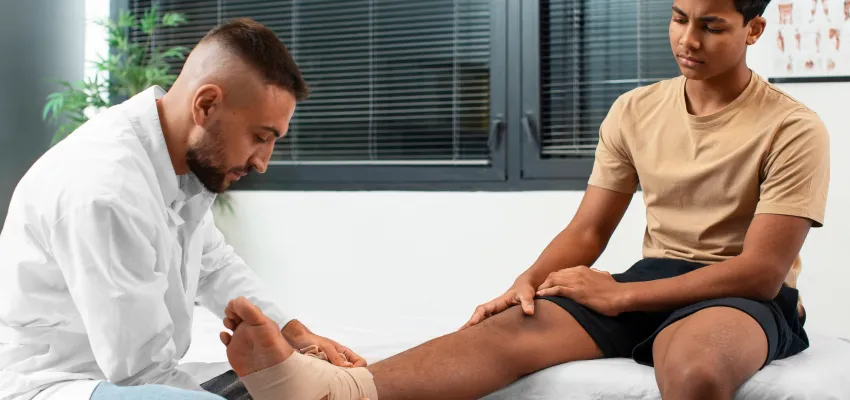5 Ways to Improve Mobility and Strength in Your Joints

Unlock pain-free movement and build lifelong joint resilience
From simple daily tasks to intense athletic performance, healthy joints are at the core of every movement you make. But over time, factors like aging, sedentary lifestyle, poor posture, and repetitive strain can take a toll on your joint health, leading to stiffness, discomfort, and even chronic injuries.
The good news? With the right strategies, you can enhance joint mobility, build strength, and protect your body for years to come — no matter your age or activity level.
Let's dive into 5 research-backed ways to keep your joints strong, mobile, and pain-free.
1. Prioritize Daily Joint Mobility Work
“Motion is lotion for your joints.”
Joint mobility refers to your ability to move a joint actively through its full range of motion. Without regular movement, joints can stiffen, lose flexibility, and become more prone to injury.
✔️ What to do:
- Dynamic Warm-Ups: Before exercise, use dynamic stretches like shoulder circles, leg swings, and hip openers to activate your joints.
- Controlled Articular Rotations (CARs): Slowly rotate joints through their full range (neck, shoulders, hips, ankles) to maintain joint integrity.
- Foam Rolling & Myofascial Release: Loosen tight muscles and fascia to improve range of motion.
💡 Why it matters:
Regular mobility work lubricates joints with synovial fluid, improves blood circulation, and ensures the surrounding connective tissue stays healthy.
🕒 Tip: Even 10 minutes daily can significantly reduce stiffness and improve flexibility — especially for desk workers or older adults.
2. Build Muscle to Support Your Joints
“Strong muscles = stable joints.”
Joints don't operate in isolation. They rely on surrounding muscles, tendons, and ligaments for stability and function. When those muscles are weak, joints have to absorb more stress — increasing wear and tear.
✔️ What to do:
- Resistance Training: Focus on compound movements like squats, lunges, pushups, and rows that strengthen multiple joints.
- Stabilizing Exercises: Incorporate single-leg exercises, planks, or resistance band work to challenge balance and joint control.
- Isometric Holds: Exercises like wall sits or glute bridges can increase joint endurance and postural strength.
💡 Why it matters:
Stronger muscles distribute load more efficiently, reduce joint stress, and protect against injury — especially for weight-bearing joints like knees, hips, and shoulders.
⚖️ Balance your training: Don't just train what you see in the mirror. Strengthen posterior chains (glutes, hamstrings, back) to avoid imbalances.
3. Support Joint Health Through Nutrition
“You are what you eat — and so are your joints.”
Joint tissue, cartilage, and connective tissues are living structures that require nutrients to regenerate, repair, and stay strong. Without proper fuel, they weaken and become vulnerable to inflammation and breakdown.
✔️ What to include in your diet:
- Omega-3 fatty acids: Found in fatty fish (salmon, sardines), walnuts, and flaxseeds. They reduce joint inflammation.
- Vitamin C: Boosts collagen synthesis — essential for ligaments and cartilage.
- Vitamin D & Calcium: Maintain bone density and joint stability.
- Protein: Supports muscle repair and tissue regeneration.
- Hydration: Water keeps synovial fluid flowing, reducing joint friction.
🔄 Supplements to consider:
- Glucosamine & Chondroitin: May help with cartilage health and reduce arthritis symptoms.
- Collagen peptides: Emerging research shows promise in improving joint flexibility and reducing joint pain.
🍽️ Tip: Avoid inflammatory foods like excess sugar, trans fats, and processed meats — they may aggravate joint issues.
4. Stay Active — But with Joint-Friendly Movements
“Rest is rust — but movement must be smart.”
While rest is important, prolonged inactivity leads to joint stiffness and muscle loss. The key is to stay consistently active with movement patterns that protect rather than harm your joints.
✔️ Joint-friendly activities:
- Walking or brisk walking: Low-impact, improves circulation and weight management
- Swimming or aqua aerobics: Reduces joint load while providing resistance
- Cycling: Great for hip, knee, and ankle mobility with minimal impact
- Tai Chi or Pilates: Focuses on control, alignment, and gentle joint movement
💡 Why it matters:
Movement improves synovial fluid production, reduces stiffness, enhances proprioception, and strengthens the muscles that support your joints.
🚨 Caution: Avoid overtraining or repetitive high-impact movements (e.g., excessive jumping, heavy running) without proper warm-ups or recovery.
5. Recover Like a Pro: Rest, Rehab, and Prevention
“What you do after a workout matters just as much.”
Even with the best workout and diet plan, joints need time to recover and regenerate. Ignoring recovery can lead to chronic pain, inflammation, or overuse injuries like tendonitis or bursitis.
✔️ Smart recovery tips:
- Post-workout stretching: Focus on major joints (hips, knees, shoulders) and surrounding muscle groups.
- Use ice or heat: Cold reduces inflammation, heat helps muscle relaxation.
- Massage and physiotherapy: Helps release tension and improve circulation.
- Sleep & rest days: Crucial for tissue repair and hormonal balance.
🛡️ Prevention strategies:
- Wear proper footwear and joint support if needed (e.g., knee sleeves, orthotics)
- Maintain good posture at work and during workouts
- Address pain early with a physiotherapist — don't wait for it to become chronic
🧠 Listen to your body: Pain is a signal, not an inconvenience. Adjust your movement or routine accordingly.
🧠 Final Thoughts: Your Joints, Your Responsibility
Strong, mobile joints are essential for pain-free movement, injury prevention, and long-term quality of life. The sooner you start prioritizing joint health, the better your body will serve you — whether you're lifting weights, chasing your kids, or simply walking up stairs.
By integrating these five practices into your lifestyle — daily mobility, strength training, smart nutrition, active living, and recovery — you're not just improving your joints; you're building a more resilient, functional, and vibrant body.
✔️ Quick Summary: 5 Essentials for Joint Health
- Daily Mobility Work: Keep joints flexible and lubricated
- Muscle Strengthening: Build stability and reduce strain
- Joint-Supportive Nutrition: Fuel repair and reduce inflammation
- Low-Impact Activity: Keep moving without excessive joint load
- Proper Recovery: Allow joints to heal, adapt, and grow stronger

